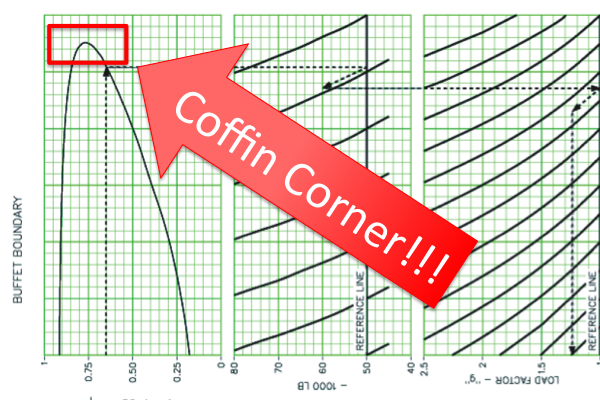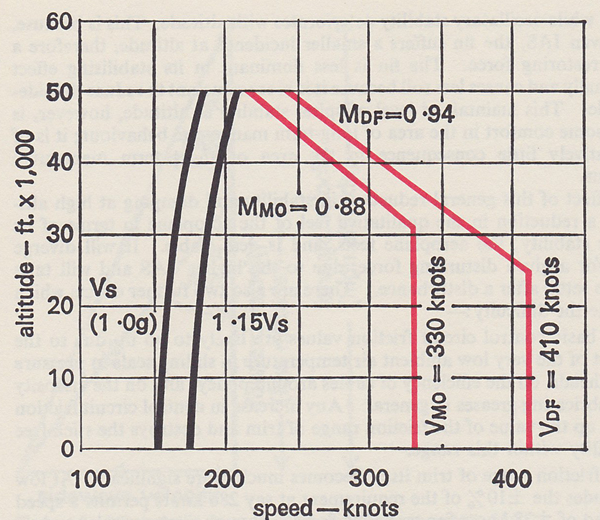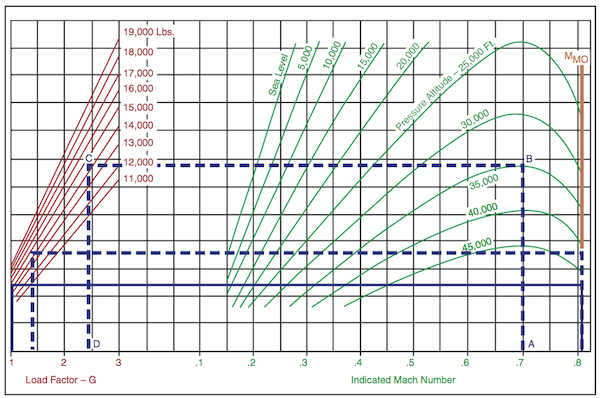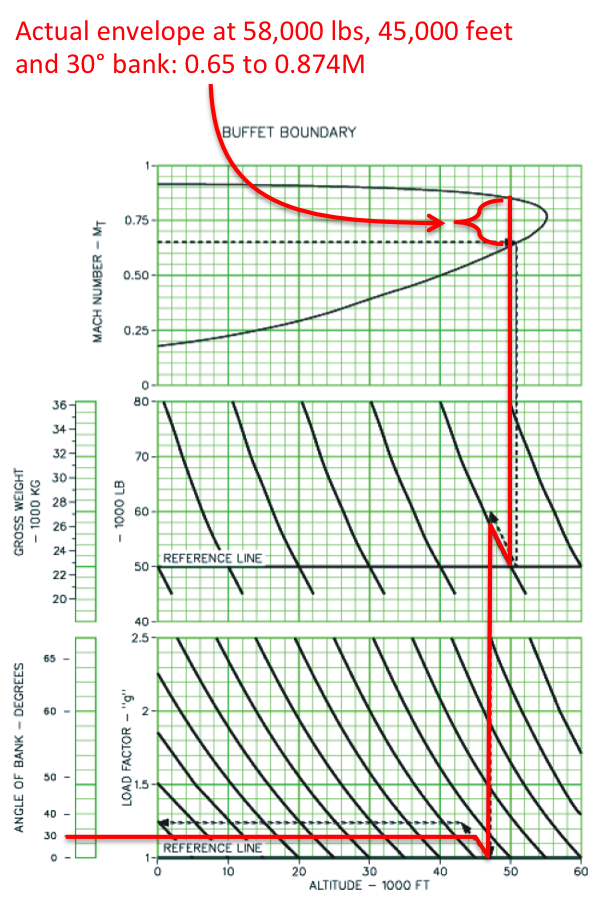Every now and then I hear somebody refuse to fly a Gulfstream above FL 350 because they fear the . . . cue dramatic music . . . coffin corner. I've spent hours at FL510 so I must be fearless. Right?
— James Albright

Updated:
2016-07-01

G450 "Coffin Corner" chart, parts hidden,
from G450 AFM, §05-08-00, figure 1
I collect aeronautical engineer books, yes I am a pretty dull person. None of them mention "coffin corner." An FAA advisory circular, AC 61-107B, mentions it while describing the aircraft maneuvering envelope. So what is this corner where you are sure to meet your demise? It is simply where your aircraft's operating envelope narrows in terms of altitude versus speed. Too slow: you stall. Too fast: you exceed design speeds.

1
Definitions
Critical Mach Number (Mcr). The free stream Mach number (M) at which local sonic flow such as buffet, airflow separation, and shock waves becomes evident. These phenomena occur above Mcr, and are as follows:
- Subsonic. M below .75.
- Transonic. M from .75 to 1.20.
- Supersonic. M from 1.20 to 5.0.
- Hypersonic. M above 5.0.
Source: Advisory Circular 61-107B, ¶1-4.e.
Q-Corner or Coffin Corner. A term used to describe operations at high altitudes where low IAS yield high TAS (as indicated by Mach number) at high angles of attack (AOA). The high AOA results in flow separation, which causes buffet. Turning maneuvers at these altitudes increase the AOA and result in stability deterioration with a decrease in control effectiveness. The relationship of stall speed to the Mcr narrows to a point where sudden increases in AOA, roll rates, and/or disturbances (e.g., clear air turbulence) cause the limits of the airspeed envelope to be exceeded. Coffin corner exists in the upper portion of the maneuvering envelope for a given gross weight and G-force.
Source: Advisory Circular 61-107B, ¶1-4.q.
High altitudes increase an aircraft's stall speed as do G-forces, narrowing the aircraft's operating envelope.
2
Restricted operating speed range

Variation of significant speeds with altitude, from D.P. Davies, figure 6.8.
- The bottom end of the achievable speed range is the stall; the top end is VDF or MDF. [DF - Maximum demonstrated diving speed.] These are absolute minimum and maximum values and are not available or permitted for normal operation. Within each limit there is a more prudent limit; the lower one can be taken as pre-stall buffet or a defined margin above the stall and the upper one as VMO or MMO. Stall speed increases with altitude as previously explained and increases with weight. So, therefore, will any function of stall speed. The lines of VMO and MMO and VDF and MDF do not vary with weight.
- [The example] is drawn for a mid-weight, say 250,000 lb.. If 1.15 Vs is acceptable as a minimum speed and VMO/MMO must be accepted as the maximum speed then the size of the permitted speed range at any altitude can be read off. Notice how it gets smaller with altitude above 30,000 ft. due to the limiting Mach number bringing down the airspeed.
Source: D.P. Davies, page 165
The so-called coffin corner can be seen in this example at 50,000 ft. This aircraft can only operate around 210 knots, 0.87 Mach, plus a very small margin. It would be prudent to fly at a lower altitude.
3
Aerodynamic ceiling

Mach buffet boundary, from FAA Handbook FAA-H-8083-3A, figure 15-11.
An airplane's indicated airspeed (IAS) decreases in relation to TAS as altitude increases. As the IAS decreases with altitude, it approaches the airspeed for the low-speed buffet boundary where pre-stall buffet occurs for the airplane at a load factor of 1.0 G. The point where high-speed Mach, IAS, and low-speed buffet boundary IAS merge is the airplane's absolute or aerodynamic ceiling. Once an aircraft has reached its aerodynamic ceiling, which is higher than the altitude limit stipulated in the AFM, the aircraft can neither be made to go faster without activating the design stick puller at Mach limit nor can it be made to go slower without activating the stick shaker or pusher. This critical area of the aircraft's flight envelope is known as coffin corner.
Source: Advisory Circular 61-107B, ¶3-2.b.(4)
- An airplane's indicated airspeed decreases in relation to true airspeed as altitude increases. As the indicated airspeed decreases with altitude, it progressively merges with the low speed buffet boundary where pre-stall buffet occurs for the airplane at a load factor of 1.0 G. The point where the high speed Mach indicated airspeed and low speed buffet boundary indicated airspeed merge is the airplane's absolute or aerodynamic ceiling. Once an airplane has reached its aerodynamic ceiling, which is higher than the altitude stipulated in the FAA-approved Airplane Flight Manual, the airplane can neither be made to go faster without activating the design stick puller at Mach limit nor can it be made to go slower without activating the stick shaker or stick pusher. This critical area of the airplane's flight envelope is known as "coffin corner."
- Mach buffet occurs as a result of supersonic airflow on the wing. Stall buffet occurs at angles of attack that produce airflow disturbances (burbling) over the upper surface of the wing which decreases lift. As density altitude increases, the angle of attack that is required to produce an airflow disturbance over the top of the wing is reduced until the density altitude is reached where Mach buffet and stall buffet converge (coffin corner).
- When this phenomenon is encountered, serious consequences may result causing loss of airplane control. Increasing either gross weight or load factor (G factor) will increase the low speed buffet and decrease Mach buffet speeds. A typical jet airplane flying at 51,000 feet altitude at 1.0 G may encounter Mach buffet slightly above the airplane's MMO (.82 Mach) and low speed buffet at .60 Mach. However, only 1.4 G (an increase of only 0.4 G) may bring on buffet at the optimum speed of .73 Mach and any change in airspeed, bank angle, or gust loading may reduce this straight- and-level flight 1.4 G protection to no protection at all. Consequently, a maximum cruising flight altitude must be selected which will allow sufficient buffet margin for necessary maneuvering and for gust conditions likely to be encountered. Therefore, it is important for pilots to be familiar with the use of charts showing cruise maneuver and buffet limits.
Source: FAA Handbook FAA-H-8083-3A, page 224
In the example diagram from the FAA Handbook, a 15,000 lb aircraft can fly to 45,000 feet and have a maneuvering envelope from 0.6 to 0.75 Mach and still be able to pull 1.4 G's. At 40,000 feet this margin expands: 0.46 Mach all the way to VMO.
4
G450 buffet boundary

G450 "Coffin Corner" chart, from G450 Airplane Flight Manual, §05-08-00, figure 1.
Here is the G450 buffet boundary chart with the altitude axis shown. On an ISA day flying at 0.80 Mach, you can make 45,000 feet at 58,000 lbs. The red line represents an aircraft at its maximum weight for the altitude and temperature in a 30° banked turn or in turbulence of similar G-loading. The chart says the aircraft will experience stall buffet at 0.65 M and reach VMO at 0.874M.
So does the G450 have a coffin corner? It would seem only possible if you somehow found yourself at 55,000 feet. So don't climb that high, okay?
References
(Source material)
14 CFR 25, Title 14: Aeronautics and Space, Federal Aviation Administration, Department of Transportation
Advisory Circular 61-107B, Aircraft Operations at Altitudes Above 25,000 Feet Mean Sea Level or Mach Numbers Greater than .75, Change 1, 9/9/15, U.S. Department of Transportation
Air Training Command Manual 51-3, Aerodynamics for Pilots, 15 November 1963
Connolly, Thomas F., Dommasch, Daniel 0., and Sheryby, Sydney S., Airplane Aerodynamics, Pitman Publishing Corporation, New York, NY, 1951.
Davies, D. P., Handling the Big Jets, Civil Aviation Authority, Kingsway, London, 1985.
Dole, Charles E., Flight Theory and Aerodynamics, 1981, John Wiley & Sons, Inc, New York, NY, 1981.
FAA-H-8083-15, Instrument Flying Handbook, U.S. Department of Transportation, Flight Standards Service, 2001.
Gulfstream G450 Airplane Flight Manual, Revision 35, April 18, 2013.
Gulfstream G450 Aircraft Operating Manual, Revision 35, April 30, 2013.
Please note: Gulfstream Aerospace Corporation has no affiliation or connection whatsoever with this website, and Gulfstream does not review, endorse, or approve any of the content included on the site. As a result, Gulfstream is not responsible or liable for your use of any materials or information obtained from this site.